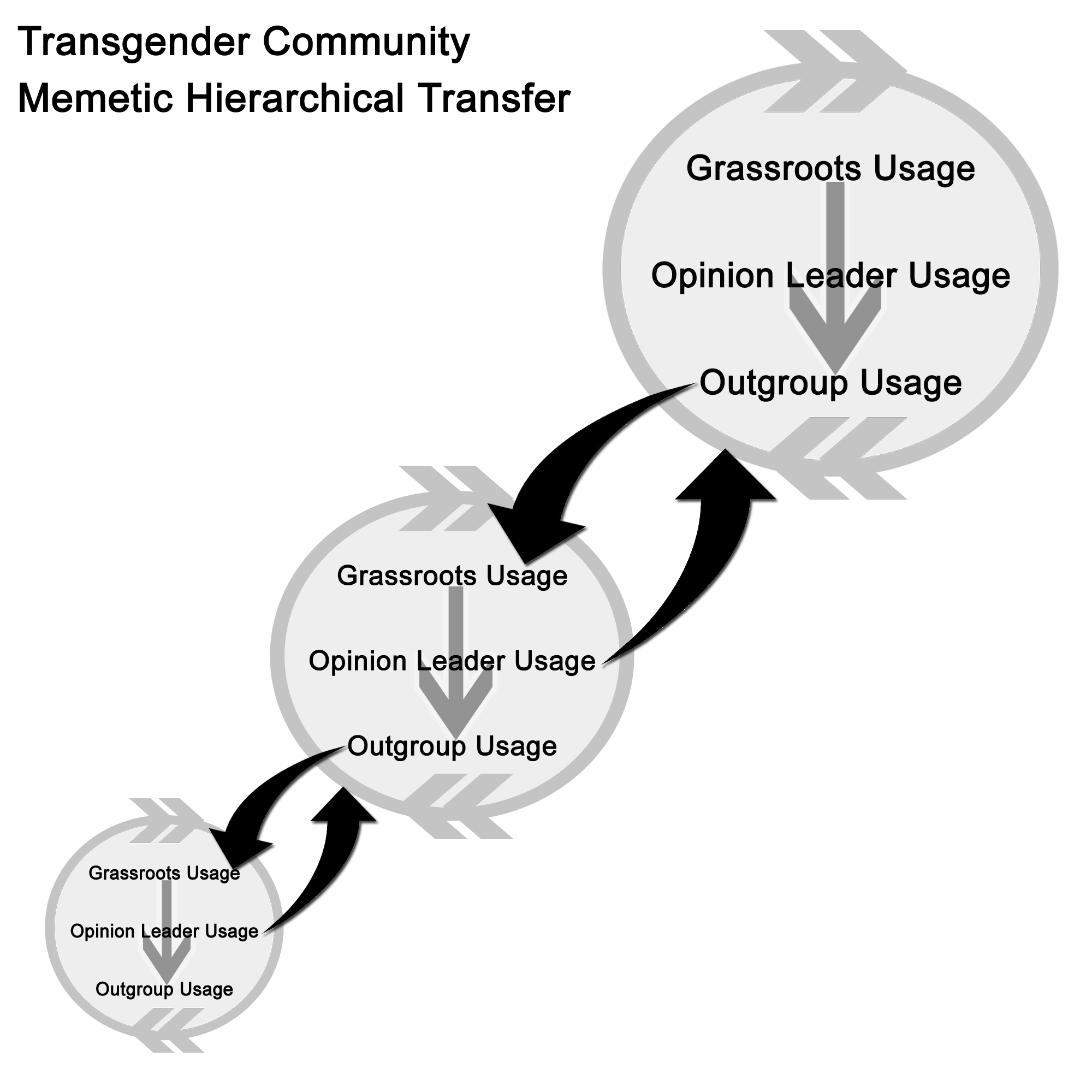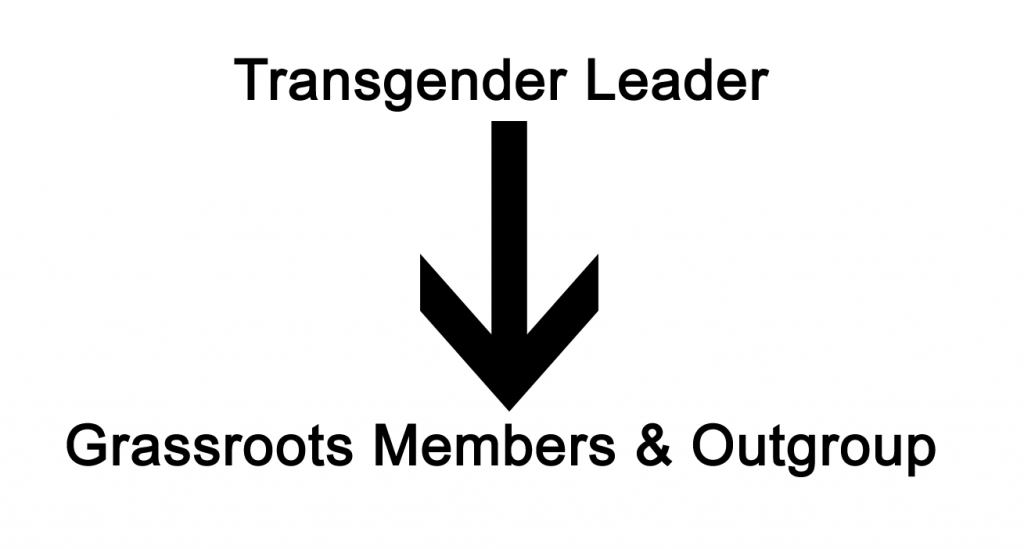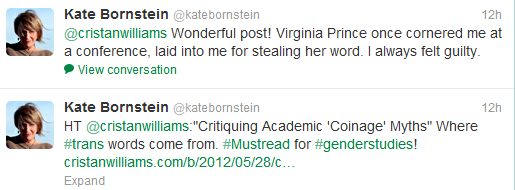By way of introduction to this post:
I got to spend last week with Dr. Rawson who flew across the country to spend some time with the Houston transgender archive*. We spent a lot of time talking about the Prince fountainhead myth that’s been propagated over the last couple of decades. We talked about how some in the blogosphere have accused academics of being rather lazy in their research, but I’m not too sure that it can be simply chalked to laziness.
As we were going through the archive we found numerous instances of Prince attempting to dictate language, classifications and assert some control over the identities people chose to take on. While neither I nor any other researcher has found even one instance where Prince claims that she and she alone coined the term “transgender,” I have found numerous instances where Tri-Ess linked people assert that Prince had.
Said another way, you trashed grannie [Virginia Prince]! You stole her linguistic contribution to the community from the community and ran down the road laughing. Lordy, lordy, lordy, you incorrigible Texans. Shame, shame shame.
I support the usage of the term “transgenderist” to mean a person living full time in a cultural gender role opposite their biological sex classification, without having altered their anatomy through SRS; “transgendered” to mean having crossed a cultural gender role perhaps permanently without SRS; and other forms of the term to be consistent with those meanings.
– Billie Jean Jones, Publisher of TV Guise, Sacramento, California, 1991
Note: Jones was working on a trans dictionary at this time.
I’ve found instances where Prince seems to believe that she had some right to control how, when and where trans terms could be used, but she always seemed to stop just short of flat out lying about her invention of the term “transgender.” Between Prince’s cheerleaders, Prince’s penchant for self-promotion and policing who used what language and how, Prince’s inflated grandiosity helped cement the Prince fountainhead myth into place. So, I don’t think that academics can be chastised too much for “lazy research”… sloppy perhaps, but certainly not lazy.
People can and do build entire identities around coinage myths. Some of us will revere or revile those who are said to have “coined” terms we use for identity labels. TS Separatists have – for years – claimed grave offense over the use of transgender because in their view, a transsexual hating crossdresser (Virginia Prince) coined the term “transgender” to describe people like herself. They asserted that they are not “transgender” because (as the myth goes) “transgender” meant a Virginia Prince-like crossdresser. Without the Prince fountainhead myth propagated by academia, I’m tempted to argue that TS Separatism would never have enjoyed what acceptance it has managed to gain.
“Coinage” is a tricky thing and depending on who is given authorship status, nuances will inevitably be built into the term after the assertion is made.
Some claim that Dr. Benjamin coined “transsexual” in the 1950s:

Others claim D.O. Cauldwell coined the term in 1949:

Still others claim that Dr. Hirschfeld coined the term in 1923:

None of these sources that assert “coinage” status to any one single source ever notes that it took about 16 YEARS for Christine Jorgensen to be referred to as a transsexual in newsprint. The process that took place to make that “transsexual” designation possible is completely ignored. Both academics and non-academics seem content to blindly accept the preposterous notion that some leader invented an identity that we lowly peons just accepted it as both personal and group identifiers.
So what happens to those creation myths now that I found the term “trans-sexed” in newsprint used to describe trans folk in 1915 – years before Hirschfeld used his German version of the term? If we move the coinage date back to 1915, what happens now that I found “transsexual” in print in 1907? But then again, maybe 1907 isn’t right either because I also found “trans-sex” used in print in 1851. Where do we draw the line and who can be asserted to have invented (ie, “coined”) the lexical compounds found in “transsexual”? If we choose to instead focus on meaning, is it proper to claim that some unknown Chicago newspaper reporter “coined” the in the lexical compound or should we instead claim Hirschfeld “coined” a German version of the lexical compound? If the term is said to have originated from a community-based source instead of medical sources, does the term gain or lose any nuances it may have for some?
If anything, what I’ve found through my research is that we should stop ascribing authorship of trans terms to any specific person. From what I’ve seen, these lexical compounds are simple enough that they are invented, forgotten, abandoned and independently reinvented** – oftentimes repeatedly so. Instead of using the language of authorship, creation and invention, I think that academics should instead simply note those sources which helped to “popularize” trans concepts.
Conferring “coinage” status upon Prince for “transgenderist” in 1978 does a grave disservice to the reality of what a community process looks like. We now have excellent evidence to make the case that THE TRANS COMMUNITY was commonly using this term years before Prince did and it will hopefully repair some of the damage caused by the academic misrepresentation of group identity and community process.

When ascribing authorship of “transgenderist” to Prince in 1978, the community becomes a top-down model instead of something organic, complex, responsive and grass-roots. I urge those of you who are researchers to re-read that previous sentence. While the idea that Prince invented an identity that she then conferred upon the masses has an almost Mosaic quality to it, the idea is ridiculous if anyone (especially those of us with experience in the trans community) thinks about it for even one moment.
While it can be said that Prince helped to popularize the grassroots identity “transgenderist,” it may not be truthfully claimed that that she created it and then passed it to the trans community. Any of the identity terms the trans community uses were not written in stone by some leader and passed down to us, their devoted followers from on high; that’s a complete distortion of community and such an oversimplification of how self-identity language comes to be used by groups that I’ve found myself tempted to add my voice to those who blame lazy academics for the fallacious origin myths that have spread through the trans community like a disease.
From what I’ve seen, identity language evolves via a somewhat complex feedback system that looks more like this:

Until now, we’ve been told that memetic transfer of identity labels happen in the follow way:

While Model 2 is certainly easier to discuss in that it’s neat and straightforward, it’s a model that dishonors a very real and complex communal feedback process which naturally occurs and gives rise to genuine group identity language. Those angry TS Separatists who bought into the Model 2 myth were right to feel anger about this proposed and propagated view of community and identity. If this simplistic process was really how community and group identities were developed, assertions of colonization, enslavement and assimilation would be absolutely valid.
On the other end, the unfortunate, yet expected, thing about The Transsexual Uprising gaining so much ground means that the attacks and anti-transsexual propaganda we have to endure is getting amped up heavily, but that’s okay, it only means we are doing something right and those who reap the benefits of our enslavement will do everything in their power to keep us ‘picking cotton’ in their unethical and unjust ‘plantation fields’ (keep us hostage in their con-brella). – Ashley Love
Under one version of Model 2, Virginia Prince coined “transgenderist” in 1978, the communist, Leslie Feinberg supposedly coined “transgender” from Prince’s term in the 1990s and these leaders forced the “transgender” identity upon us all. It is only through the propagation of Model 2 that such inane assertions enjoy the veneer of plausibility. Model 2 misrepresents the reality of community so that it becomes a fictional oligarchy. MANY trans people have bought into this ridiculously simplistic (to the point of absurdity!) model. It’s time for researchers to stop using Model 2 no matter how poetically convenient it may be.
The transgender community IS NOT one symmetrically monolithic mass; rather, it’s an exquisitely diverse and interlocking system of smaller and smaller interlocked groupings all linked by gradations of common experiences and history. Model 2 asks us to believe that somehow an identity pronouncement can be made from on high and that all of these very, very different groupings with very, very different interests and needs – for some inexplicable reason – will then simultaneously accept and take on this pronouncement of identity. The trans community contains within it disparate groups which would have virtually no contact with each other outside of the realm of a shared experience and history. These shared gradations of experience and history facilitates communication and hence, the reality of community itself. The ham-fisted propagation of Model 2 not only erases this historical truth for future academics, but it also distorts the way in which the trans community views itself.
In fact, I would assert that any type of identity peri-meme is doomed to fail if it cannot successfully navigate through a communal vetting process like the one I’ve represented in Model 1. Disregarding this communal vetting process virtually erases what community really is. Moreover, it sacrifices what is important about community language to an apparent academic need to assign fountainhead status to one single source.
Take Prince’s trans+genderal lexical compound that appeared in print just 5 months prior to the 1970 TV (Television) Guide’s trans+gendered lexical compound. Princes “transgenderal” – a term she claimed to represent only people like herself – never caught on and she completely abandoned the term. No lateral transference evidence has been found to exist wherein Prince’s 1-use term is linked to a later use of that same term (especially when the term was used in 1977 to describe transsexualism) nor is there evidence linking Prince’s abandoned term to other later trans terms. Since this one instance (and immediate abandonment of) the lexical compound of trans+genderal (genderal, being a term Prince liked to use) appeared 5 months prior to “transgendered” showing up in the TV Guide to reference a transsexual character, should academics therefore assert that Prince is where all transgender terms come from? If that’s the top-down model academics wish to cling to, should we also now assert that the 1850s trans+sex lexical compound is where the term “transsexual” comes from? Again, I assert that if academics want to affix coinage status to any one place, it must be conferred upon something like the continuous process I detailed in Model 1. Prince’s transgenderal failed the community vetting process in the same way that other early trans terms (eg. Phyllis Frye’s transgenderous) failed to successfully navigate that process. Only those identity terms which resonate sufficiently throughout and between the various gradations of groupings will become real identity terms.
Seriously, academic folks. Stop it with the ridiculous Mosaic simplicity! Please stop misrepresenting how community functions in the development group identity!
*Dr. Rawson has traveled to practically all trans archival repositories known to exist. He said that the Houston trans archive is absolutely unique – that there literally isn’t another trans archive like it anywhere… which is kinda cool!
**What was wonderful about the visit with Dr. Rawson was that we also discovered the earliest know in-print usage of “transgenderist” yet known to exist (pictured above). Working off of a clue found in one of Phyllis Frye’s personal letters, we tracked down an early 1975 community survey – possibly the very first trans initiated survey of our own community – published in a trans newspaper wherein the survey asks how the respondents self-identified. The choices were: Transvestite, Transsexual, Transgenderist and Other. It’s obvious that the term “transgenderist” was in wide usage within the community by early 1975 and furthermore, it’s obvious that at that point in time, “transgenderist” was a distinct category from transvestite.
Additionally, he turned up a couple of early 1970s usages of “transgenderal” as well. From the context, it’s clear that those using this term did not get it from Prince. Most interesting to me was a 1977 academic usage Dr. Rawson found which used “transgenderal” to describe transsexuals who were going through genital reconstructive surgery. We also came across a tantalizing clue wherein “transgender” may have been used as early a 1965 (the source I’m tracking down) and possibly even 1955 (the source Dr. Rawson is tracking down).
I’ll be posting the new usage instances on my research blog.

Critiquing Academic “Coinage” Myths: The Virginia Prince Fountainhead Myth is Dead: http://t.co/lR9HnWxp #transgender #history
RT @cristanwilliams: Critiquing Academic “Coinage” Myths: The Virginia Prince Fountainhead Myth is Dead: http://t.co/lR9HnWxp #transgender #history
HT @cristanwilliams:”Critiquing Academic ‘Coinage’ Myths” Where #trans words come from. #Mustread for #genderstudies! http://t.co/2woTzXaP
Virginia Prince did not have the power to define transgender http://t.co/SLvD5pgH